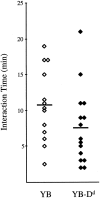Inhibitory receptors alter natural killer cell interactions with target cells yet allow simultaneous killing of susceptible targets
- PMID: 10510090
- PMCID: PMC2195645
- DOI: 10.1084/jem.190.7.1005
Inhibitory receptors alter natural killer cell interactions with target cells yet allow simultaneous killing of susceptible targets
Abstract
Inhibitory receptors expressed on natural killer (NK) cells abrogate positive signals upon binding corresponding major histocompatibility complex (MHC) class I molecules on various target cells. By directly micromanipulating the effector-target cell encounter using an optical tweezers system which allowed temporal and spatial control, we demonstrate that Ly49-MHC class I interactions prevent characteristic cellular responses in NK cells upon binding to target cells. Furthermore, using this system, we directly demonstrate that an NK cell already bound to a resistant target cell may simultaneously bind and kill a susceptible target cell. Thus, although Ly49-mediated inhibitory signals can prevent many types of effector responses, they do not globally inhibit cellular function, but rather the inhibitory signal is spatially restricted towards resistant targets.
Figures






Similar articles
-
Natural killing of MHC class I(-) lymphoblasts by NK cells from long-term bone marrow culture requires effector cell expression of Ly49 receptors.Int Immunol. 1999 Aug;11(8):1239-46. doi: 10.1093/intimm/11.8.1239. Int Immunol. 1999. PMID: 10421781
-
Acquisition of external major histocompatibility complex class I molecules by natural killer cells expressing inhibitory Ly49 receptors.J Exp Med. 2001 Nov 19;194(10):1519-30. doi: 10.1084/jem.194.10.1519. J Exp Med. 2001. PMID: 11714758 Free PMC article.
-
Relation of natural killer cell line NK-92-mediated cytolysis (NK-92-lysis) with the surface markers of major histocompatibility complex class I antigens, adhesion molecules, and Fas of target cells.Oncol Res. 1998;10(10):483-9. Oncol Res. 1998. PMID: 10338151
-
Dual effects of cytokines in regulation of MHC-unrestricted cell mediated cytotoxicity.Crit Rev Immunol. 1993;13(1):1-34. Crit Rev Immunol. 1993. PMID: 8466640 Review.
-
Human natural killer cells: Molecular mechanisms controlling NK cell activation and tumor cell lysis.Immunol Lett. 2005 Aug 15;100(1):7-13. doi: 10.1016/j.imlet.2005.07.004. Immunol Lett. 2005. PMID: 16109445 Review.
Cited by
-
Stable masking by H-2Dd cis ligand limits Ly49A relocalization to the site of NK cell/target cell contact.Proc Natl Acad Sci U S A. 2007 Mar 6;104(10):3978-83. doi: 10.1073/pnas.0607418104. Epub 2007 Feb 26. Proc Natl Acad Sci U S A. 2007. PMID: 17360463 Free PMC article.
-
Cd226-/- natural killer cells fail to establish stable contacts with cancer cells and show impaired control of tumor metastasis in vivo.Oncoimmunology. 2017 Jul 5;6(8):e1338994. doi: 10.1080/2162402X.2017.1338994. eCollection 2017. Oncoimmunology. 2017. PMID: 28920003 Free PMC article.
-
Transfer of NKG2D and MICB at the cytotoxic NK cell immune synapse correlates with a reduction in NK cell cytotoxic function.Proc Natl Acad Sci U S A. 2006 Jul 25;103(30):11258-63. doi: 10.1073/pnas.0600721103. Epub 2006 Jul 18. Proc Natl Acad Sci U S A. 2006. PMID: 16849432 Free PMC article.
-
Controlling natural killer cell responses: integration of signals for activation and inhibition.Annu Rev Immunol. 2013;31:227-58. doi: 10.1146/annurev-immunol-020711-075005. Annu Rev Immunol. 2013. PMID: 23516982 Free PMC article. Review.
-
Inhibitory signaling blocks activating receptor clustering and induces cytoskeletal retraction in natural killer cells.J Cell Biol. 2011 Feb 21;192(4):675-90. doi: 10.1083/jcb.201009135. J Cell Biol. 2011. PMID: 21339333 Free PMC article.
References
-
- Gumperz J.E., Parham P. The enigma of the natural killer cell. Nature. 1995;378:245–248. - PubMed
-
- Lanier L.L. Natural killer cell receptors and MHC class I interactions. Curr. Opin. Immunol. 1997;9:126–131. - PubMed
-
- Yokoyama W.M. Natural killer cell receptors. Curr. Opin. Immunol. 1998;10:298–305. - PubMed
-
- Seaman W.E., Eriksson E., Dobrow R., Imboden J.B. Inositol trisphosphate is generated by a rat natural killer cell tumor in response to target cells or to crosslinked monoclonal antibody OX-34possible signaling role for the OX-34 determinant during activation by target cells. Proc. Natl. Acad. Sci. USA. 1987;84:4239–4243. - PMC - PubMed
Publication types
MeSH terms
Substances
Grants and funding
LinkOut - more resources
Full Text Sources
Other Literature Sources
Research Materials

